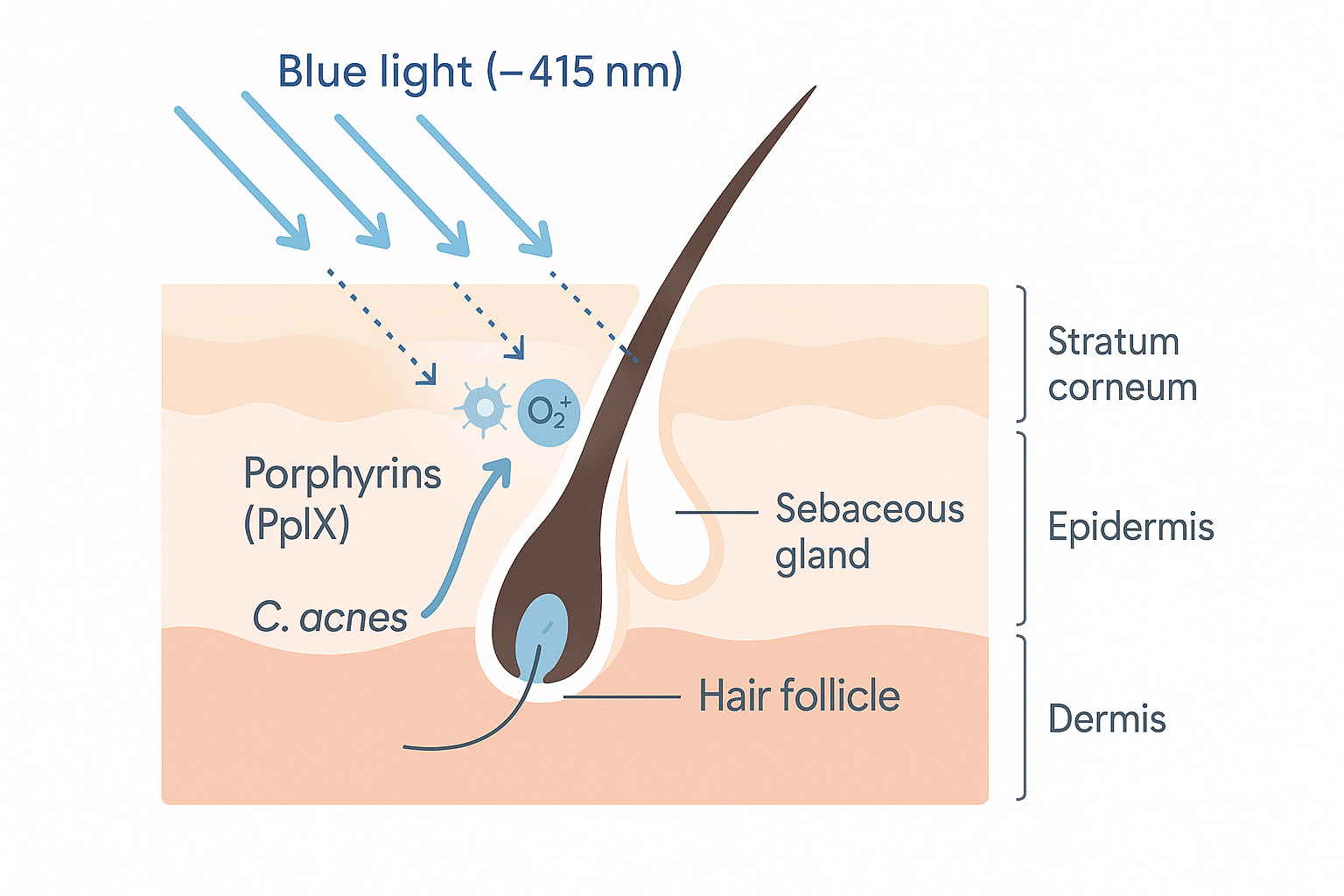Blue Light Therapy for Acne: How It Works
A clear, science-led guide to how blue wavelengths act on acne-causing bacteria, what the typical course looks like, and when to combine with red or near-infrared LED.
Updated 15 October 2025 · Educational content — not a substitute for medical advice.

Blue light (~415 nm) excites porphyrins within Cutibacterium acnes, generating reactive oxygen species that damage the bacteria.
How blue light targets acne
Wavelength & target: Blue LED typically centres around ~415 nm (sometimes 405–420 nm). At this band, light penetrates the superficial skin layers and is absorbed by porphyrins produced by Cutibacterium acnes (formerly Propionibacterium acnes).
- Photo-excitation of porphyrins: When porphyrins absorb blue light, they enter an excited state.
- Reactive oxygen species (ROS): The excited porphyrins transfer energy to oxygen, creating ROS (e.g., singlet oxygen).
- Selective bacterial damage: ROS disrupts bacterial membranes and internal structures, reducing acne-causing bacteria load.
Blue light doesn’t rely on antibiotics or systemic drugs — it leverages the bacteria’s own porphyrins for a local photodynamic effect.
Why combine with red light?
Red (≈630–670 nm) and near-infrared (≈800–850 nm) penetrate deeper, supporting calming of inflammation, circulation and tissue recovery. Many protocols pair blue (to reduce bacteria) with red (to settle inflammation and support repair).
What a typical course looks like
- Session time: 15–20 minutes of blue LED exposure per area (with protective eyewear).
- Cadence (initial): Often 2–3 sessions per week for several weeks.
- Maintenance: Taper to weekly/fortnightly based on response.
- Results timeline: Many notice calmer skin within 2–4 weeks; clarity improves across a course.
Consistency is more important than single higher-dose sessions.
Safety, side-effects & contraindications
- Downtime: None; temporary pinkness or dryness possible.
- Avoid / use caution: Photosensitising conditions/medicines; active infection/open lesions; severe photophobia.
- Medications: Disclose topical/systemic acne meds (e.g., isotretinoin) — protocols may be adjusted.
- Aftercare: SPF daily; keep routines gentle on the day of treatment; avoid heat/sauna immediately after.
Frequently asked
How many sessions do I need?
Many see best results with an initial series (e.g., 6–8 sessions), then spaced maintenance. Your clinician will advise cadence.
Does it hurt?
No. Expect bright light and mild warmth while you wear protective eyewear. It’s generally very comfortable.
Are home LED devices enough?
They can help mild acne with diligent, frequent use, but they are typically lower power than clinic systems.
How soon will I notice a difference?
Calming often appears by 2–4 weeks; clarity continues to improve across your course and maintenance.
This guide explains mechanisms and typical protocols. Your practitioner will confirm suitability and adjust parameters for your skin.
LED Blue Light Therapy
While red, white and blue LED Light Therapies are often used in combination at Santi, blue light’s ability to eradicate acne makes it a premium treatment. Acne light therapy works by penetrating just below the skin’s surface, blue light targets acne at the source by regulating over-active oil glands and killing acne-causing bacteria. Deep-reaching yet non-invasive, the anti-microbial effects of blue light make it a popular and side-effect-free treatment for acne and inflamed skin. Medically, blue light can be used to treat both precancerous and cancerous skin lesions as well as serious cases of photo-damage. Finally, with ongoing research into its effectiveness as a treatment for depression, blue light is proving to be an exciting LED option.
Acne
Acne Light Therapy or Blue light is an ideal alternative to other acne treatments as it is non-invasive, non-toxic and will not adversely effect your skin. No redness, dryness or peeling is evidenced, it can target bacteria without antibiotics and can help to control the production of oil (sebum) without the need for vitamin A derivatives. As a proven drug-free option, blue light therapy can be used alone or in conjunction with other treatments, depending on the type and severity of your acne. The FDA has approved blue light therapy for the treatment of moderate Acne Vulgaris, especially in cases which have failed to respond to other therapies. Blue light therapy is often combined with red light therapy to control existing inflammation and reduce the appearance of scars. Combined light therapy has the added benefits of improving general skin texture, fading sunspots and minimising any previous acne scarring.
